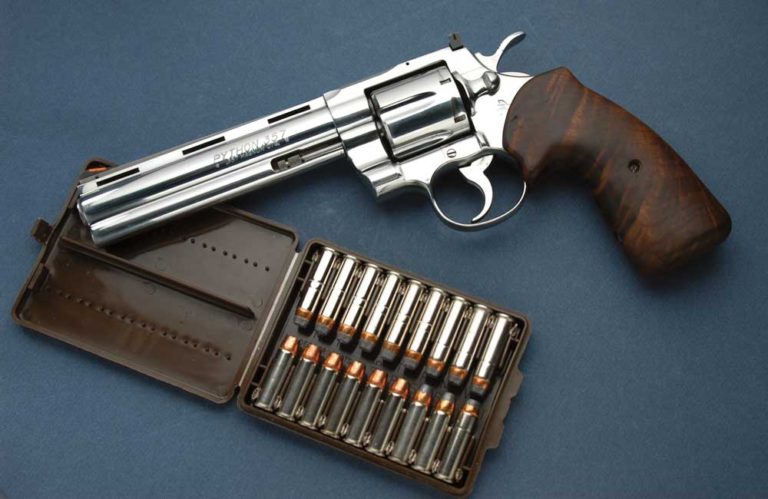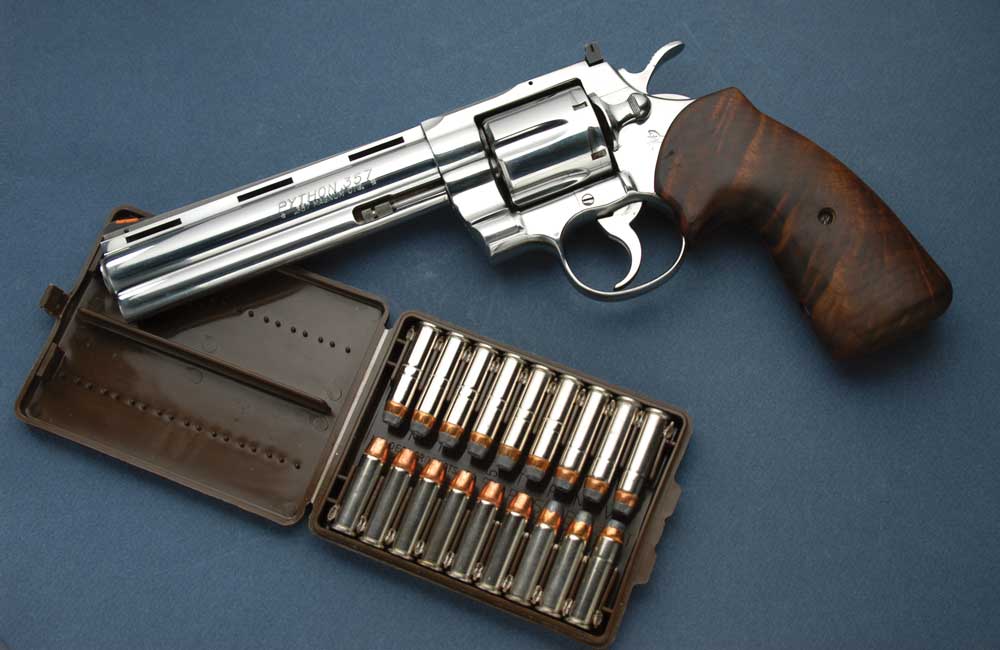

Forty years ago, one handgun caliber dominated all others, regardless the intended application. It didn’t matter whether it was used by law enforcement, for self-defense, the relatively new sport of handgun hunting for whitetail deer, or for just plain fun and plinking—the most popular handgun at the time was a revolver chambered for the .357 Magnum.
The adoption by the United States military of the 9mm Beretta, in 1985, changed things dramatically for both revolver shooters and devotees of the beloved 1911 .45, as both law enforcement agencies and civilian consumers stampeded to a variety of semi-auto pistols in 9x19mm caliber. These guns held far more rounds in reserve than did the six-shot .357 Magnum or the 7+1 1911 .45, but, for a major part of the 20th century, the .357 Magnum held sway. Many experts feel that, even today, if the firearms world had not witnessed the tidal surge move to semi-autos during the 1980s, the .357 Magnum would still be the most popular handgun caliber out there.
Origins
The .357 Magnum cartridge was introduced, in 1935, by Smith & Wesson, but Winchester Ammunition worked directly with S&W to bring it to market. Major Douglas B. Wesson and Phil Sharp were responsible for much of the final developmental work, although it is noted in several historical records that both authorities consulted with Elmer Keith because of his experience in developing heavy bullet loads with higher than normal muzzle velocities for the .38-44 cartridge. The .38-44 had been an attempt to develop a more powerful cartridge than the standard police .38 Special. Smith & Wesson, prior to the introduction of the .357 Magnum, even made a heavy-frame revolver that was nominally a .38 Special revolver, but it was referred to as the “.38-44.”
At the time of its introduction, the .357 Magnum was, in fact, the most powerful handgun round in production. The original load chronographed 1,510 fps with a 158-grain bullet out of an 8¾-inch barrel. It certainly wasn’t the first attempt to create a powerful handgun cartridge. Other startups had come before it. The most notable was that by an Englishman, H. W. Gabbet-Fairfax, who’d developed, around 1900, a self-loading pistol employing a cartridge called the 9mm Mars. It had a reported muzzle velocity of 1,607 fps with a bullet weight of 156 grains. But the British military rejected it after trials, and neither the gun nor that cartridge ever achieved commercial success.
Smith & Wesson chambered its heaviest revolver frame (later known as the N-frame) for it. The revolver was a special order item introduced during the height of the Great Depression. Each revolver was registered with the factory and came with a certificate designating this registration. The Smith & Wesson “Registered Magnum” and its cartridge soon acquired a mystique that created a following among legendary lawmen (J. Edgar Hoover received Registration No. 1), military generals (one of General George S. Patton, Jr.’s famous ivory revolvers was Registered Magnum No. 506), and high-profile Hollywood movie actors (a Registered Magnum supposedly belonging to Clark Gable sold at a high-end gun auction in 2012).
Originally, Smith & Wesson felt the round should be fired through the 8¾-inch barrel, but because the early .357 Magnum Registered revolvers were all custom orders, they had been made with a wide variety of individual characteristics. These revolvers have been found with 23 different barrel lengths, as well as a number of non-cataloged sight and grip combinations.
.357 Advantages

The designation “.357” refers to the bore diameter, which is also the bore diameter of the less powerful and older .38 Special cartridge. The .38 Special was introduced in 1902, also by Smith & Wesson, to provide a .38-caliber handgun cartridge that was more powerful and effective than any of the previously seen .38-caliber rounds such as the .38 S&W, the .38 Short Colt, and the .38 Long Colt. The latter had served briefly as the standard service handgun round of the military services and was blamed, in large part, for its many failures to stop antagonists during the Spanish-American War and the insurrection in the Philippines.
The .38 Special was initially loaded with a 158-grain round-nose lead bullet and it had a muzzle velocity of 855 fps out of a standard service-length revolver barrel. While proving extremely popular with American law enforcement, the .38 Special also experienced criticisms for failures to stop armed bad guys, particularly during the more violent episodes of the 1930s. These criticisms are what lead to, first, the development of .38-44 rounds (.38-caliber loads meant for use in a .44-sized revolver frame), and then, ultimately, to the .357 Magnum.
More .357 Magnum Articles:
- The Advantage Of The .357 Rifle
- Self-Defense: .357 SIG And .357 Magnum Ammo Considerations
- Classic Guns: The Smith & Wesson .357 Magnum Revolver
Still, by the late 1940s and early 1950s, the .38 Special was the dominant handgun service round in American law enforcement. This popularity was due to its inherent accuracy and relatively easy recoil ,and, with its straight-walled case, it was an easy round for the recreational shooter to reload.
When the designers created the .357 Magnum, they took the existing .38 Special case and simply lengthened it by 1/10-inch, mostly to prevent chambering of this new, more powerful, far higher chamber pressured round from being loaded in the older, weaker guns of .38 Special design. The bullet diameter, naturally, is the same for both the .38 Special and the .357 Magnum. For training or practice purposes, this meant the .38 Special round could be safely loaded and fired in any cylinder chambered for the .357 Magnum; that was and is probably the greatest asset of any .357 Magnum handgun, its versatility across both rounds.
This article is from the book, Best of Gun Digest: Handguns & Handgun Shooting.

Next Step: Get your FREE Printable Target Pack
Enhance your shooting precision with our 62 MOA Targets, perfect for rifles and handguns. Crafted in collaboration with Storm Tactical for accuracy and versatility.
Subscribe to the Gun Digest email newsletter and get your downloadable target pack sent straight to your inbox. Stay updated with the latest firearms info in the industry.

![Best Concealed Carry Guns In 2025 [Field Tested] Wilson Combat EDC X9S 1](https://gundigest.com/wp-content/uploads/Wilson-Combat-EDC-X9S-1-324x160.jpg)


![Best 9mm Carbine: Affordable PCCs [Tested] Ruger Carbine Shooting](https://gundigest.com/wp-content/uploads/Ruger-Carbine-Shooting-100x70.jpg)
![Best AR-15: Top Options Available Today [Field Tested] Harrington and Richardson PSA XM177E2 feature](https://gundigest.com/wp-content/uploads/Harrington-and-Richardson-PSA-XM177E2-feature-100x70.jpg)
